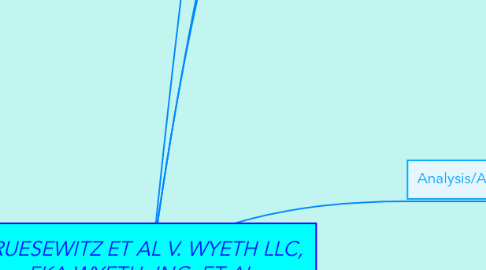
1. Subsequent Caselaw
1.1. This case has been cited, not only in other vaccine litigation before the Ct of Federal Claims, but in other matter that reference the limits of federal preemption . The other interesting thing about this case is its relative recency considering how the history of vaccine litigation in the US.
2. Issue Before the Court
2.1. Does the NCVIA’s preemption provision (42 USC §300aa-22(b)(1)) bar state law design-defect claims against vaccine manufacturers?
3. Facts
3.1. Parties
3.1.1. Plaintiffs - Hannah Bruesewitz, a minor, and her parents.
3.1.2. Defendant – Wyeth, a pharmaceutical company that owns Lederle Laboratories, a vaccine manufacturer.
3.2. Background
3.2.1. Policy Background
3.2.1.1. i. Diphtheria, tetanus and pertussis (DTP) vaccines successfully prevented the spread of such diseases, but led to an increase of vaccine related tort litigation.
3.2.1.2. ii. This led to a destabilization of the manufacturing market, vaccine shortages, and left only one domestic vaccine manufacturer, Lederle Laboratories.
3.2.1.3. iii. Despite increased litigation, some parents were complaining that they were unable to obtain compensation for legitimate vaccine related injury.
3.2.1.4. iv. Recognizing that vaccines are only effective if a large percentage of the population are inoculated, Congress enacted the National Childhood Vaccine Injury Act of 1986 (NCVIA).
3.2.1.4.1. 1. A person seeking compensation for a vaccine related injury may file a petition for compensation in the US Court of Federal Claims.
3.2.1.4.2. 2. The petitioner may accept the court’s judgment (rendered quickly) and forgo a tort suit, or reject it and file suit against the manufacturer.
3.2.1.4.3. 3. Even if a civil suit is filed, a manufacturer is not liable for any adverse unavoidable side effects if the manufacturer complied with all regulatory requirements. 42 USC §300aa-22(b)(1).
3.2.2. Factual Background
3.2.2.1. i. In April 1992 at 6 months of age, Hannah Bruesewitz received a diphtheria, tetanus and pertussis vaccine (DTP) manufactured by Lederle Laboratories.
3.2.2.2. ii. Within 24 hours of receiving the DTP vx, Hannah experienced repeated seizures, and was eventually diagnosed with “residual seizure disorder” and “developmental delay.”
3.2.2.3. iii. Hannah still has these diagnoses.
3.3. Procedural History
3.3.1. a. In 1995, Plaintiffs filed a vaccine injury petition in the US Ct of Federal Claims. This claim was denied, but they were awarded $126.8k attorney’s fees/costs.
3.3.2. b. Plaintiffs rejected the above judgment and filed a strict liability and design-defect action against Defendants in the US District Ct. for the Eastern District of PA. Court held that PA law was preempted by 42 USC §300aa-22(b)(1).
3.3.3. c. The Third Circuit affirmed the ruling, and US Supreme Court granted certiorari.
4. Rules of Law
4.1. a. Statutory Construction - Does the plain language of 42 USC §300aa-22(b)(1) read to bar state law design-defect suits?
4.1.1. i. Plain language is not clear.
4.1.2. ii. Traditional State Law Product Liability have one of three claims: 1. Defective manufacture; 2. Inadequate warnings; or 3. Defective design.
4.1.3. iii. Court notes that Congress chose to explicitly reference two of the three claims in the preemption clause (1 and 2). The one Plaintiffs are pursuing is the one not explicitly mentioned by Congress (design-defect).
4.2. b. Legislative History of NCVIA – what did Congress intend when it passed the preemption clause language contained in 42 USC §300aa-22(b)(1)?
5. Analysis/Application
5.1. Plaintiffs' Argument
5.1.1. i. Plain language unclear – should be interpreted to read that side effects are “unavoidable” if there is a feasible alternative design that doesn’t contain the harmful element.
5.1.2. ii. Argues that traditional State Law Product Liability have one of three claims: 1. Defective manufacture; 2. Inadequate warnings; or 3. Defective design.
5.1.3. iii. Since Congress explicitly preempted defective manufacture and inadequate warning cases in 42 USC §300aa-22(b)(1), by the statutory principle of expressio unius est exclusio alterius, Congress must have chosen to allow vaccine-injured children to pursue state law design-defect claims.
5.1.4. iv. Had Congress wanted to exempt all product liability claims, the language of the statute could have simply read, “No vaccine manufacturer shall be liable for state law product liability claims….”
5.1.5. v. Legislative history of NCVIA supports the compensation of vaccine injured children.
5.2. Defendant's Argument
5.2.1. i. Plain language also unclear, but only reading where all of the words of 42 USC §300aa-22(b)(1) could have effect would be if design defects were implicitly preempted. If manufacturers could be liable for design defect cases, there is no effect to the word “unavoidable.”
5.2.2. ii. Argues that Congress would not introduce the design defect liability, or something as specific as a feasible alternative design test by implication, when all other aspects of vaccine production are micromanaged.
5.2.3. iii. Legislative history supports the preemption of design-defect cases, and as well as the interests of having a thriving vaccine research industry and a public that is fully vaccinated. These public policy aims would be better accomplished by immunizing manufacturers from design defect claims.
